Email marketing is definitely not dead. A whopping 89% of marketers in all industries and 93% of those serving the B2B market use it as their main communication and marketing channel.
Email personalization makes the most of users’ and customers’ data and insights to provide valuable emails that are more likely to win a click-through or a purchase. It’s all about targeting email campaigns so they go to the inbox of the right user, at the right time.
Getting the first name and seasonal greetings on any marketing email is the bare minimum at this point. However, SaaS marketers are struggling to move the needle from personalization, to hyper-personalization — going beyond using the first name in a subject line.
It’s trickier to manage the right data as Leslie Venetz, founder at Sales Team Builder, says:
“To earn you the right to their inbox, the right to their calendar, and ultimately, the right to their business.”
Thankfully, with the right email personalization strategy, you’ll get to add true value to your customers day and see the results you’ve been struggling to get.
Here, we’ll go through expert advice and tips for you to nail email personalization once and for all.
In this guide, you will learn:
- What is SaaS email personalization?
- What can go wrong with SaaS email personalization?
- SaaS email personalization strategies to try (with real-life examples)
- Benefits of email personalization
- A SaaS tool for email marketing
- SaaS personalized email FAQs
Don’t wait for the muse. Apply this step-by-step method to write high-performing email campaigns in hours, not weeks.
What is SaaS email personalization?
Email personalization is a strategy that uses insightful data about the user to deliver highly targeted and relevant emails. It increases click-through rate and over all brand appreciation. Amit Raj, founder of The Links Guy says:
“Email personalization is an art as well as a science.”
To find the strategy that suits you, you need to know your goals as well as the problems you might encounter when trying to achieve them. To do this, we need to first understand what SaaS email personalization is.
Let’s quickly look at the main differences between ecommerce and SaaS email personalization.
A typical ecommerce email personalization campaign includes things like targeted advertising depending on your previous search, friendly greetings with your names, product suggestions, and birthday emails. Ecommerce personalization can survive on user first name in subject lines, showcasing products based on previous research, and segmentation through tags.
Like Jordie van Rijn, email marketing specialist at eMailMonday and founder at Email Vendor Selection, says, ecommerce email personalization is about making the user picture themselves using the product. Personalization is used in ecommerce because although the product might be the same, the use that it’s given will be different.
However, when it comes to SaaS email personalization, there are a few differences. Although the aim is to get the user to feel seen and heard, with SaaS companies you also want to deliver much more value through personalization.
After all, a ‘Hello, Jane!’ or ‘We hope you enjoy your birthday, John’, won’t be as impactful to a SaaS user, than it would be to an ecommerce customer.
SaaS customers can be much more demanding than ecommerce ones. After all, they’re really looking for solutions to their business-building problems, and the solutions they need are often dependent on tool subscriptions — repeat payments — over a one-time purchase.
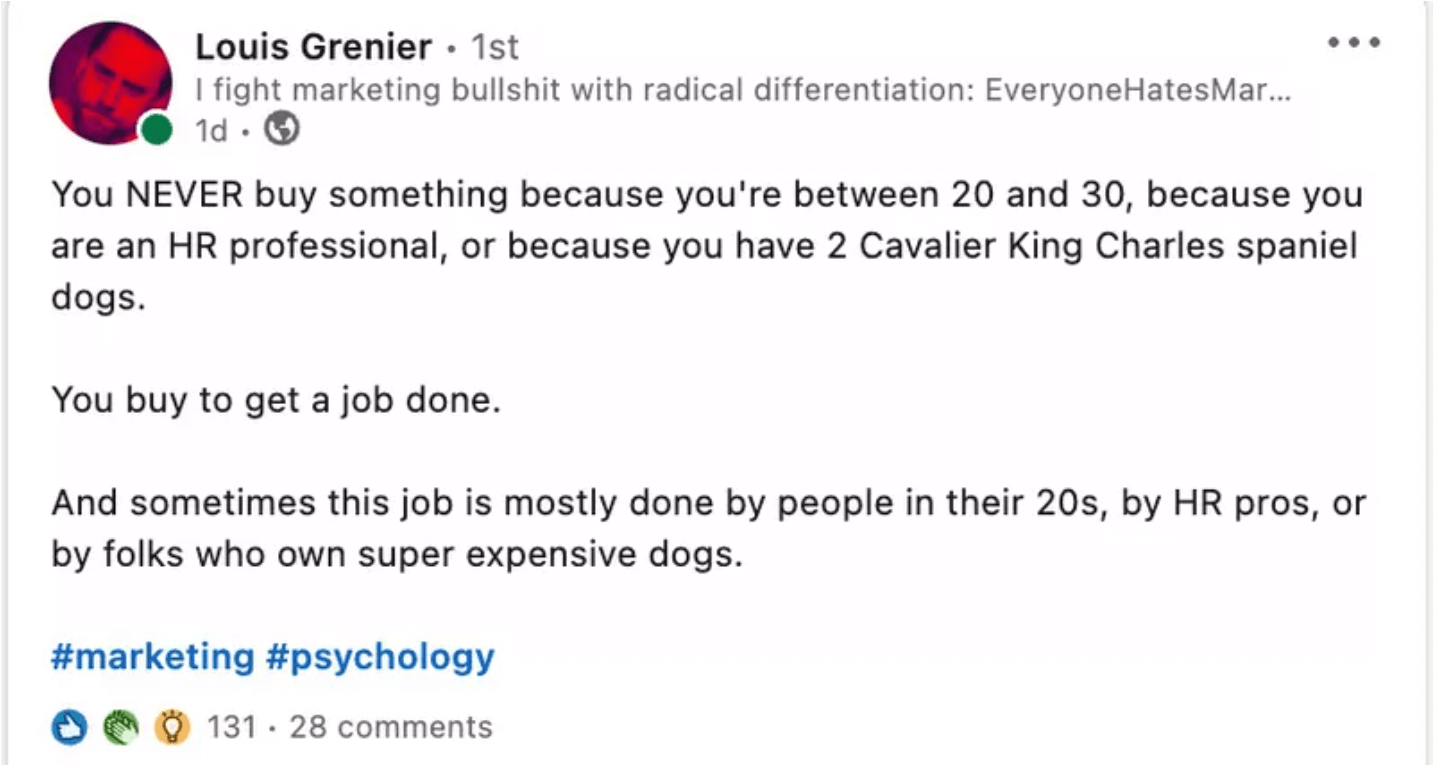
This friendliness and familiarity, although a nice-to-have, won’t really sell your tool any better. Instead, targeting the right potential customer, and proving how you can truly help them achieve their job-to-be-done or solve pain points is what will get you in their inbox, and their business — fast.
What can go wrong with SaaS email personalization?
Before we get down to what makes a great and effective SaaS email personalization campaign, we need to see the mistakes. The falls. The big no-no’s.
Personalization can go wrong, in many ways via a misuse or overuse of data. Remember, just because you have tons of personal data of your user doesn’t mean you need to use all of it.
Too little personalization misses the point, and too much might feel a bit creepy for users and scare them away. You need to find the right balance to the amount of customer data you feed back to them.
Below you can see what the main problems are when it comes to personalization and how much it can frustrate users:
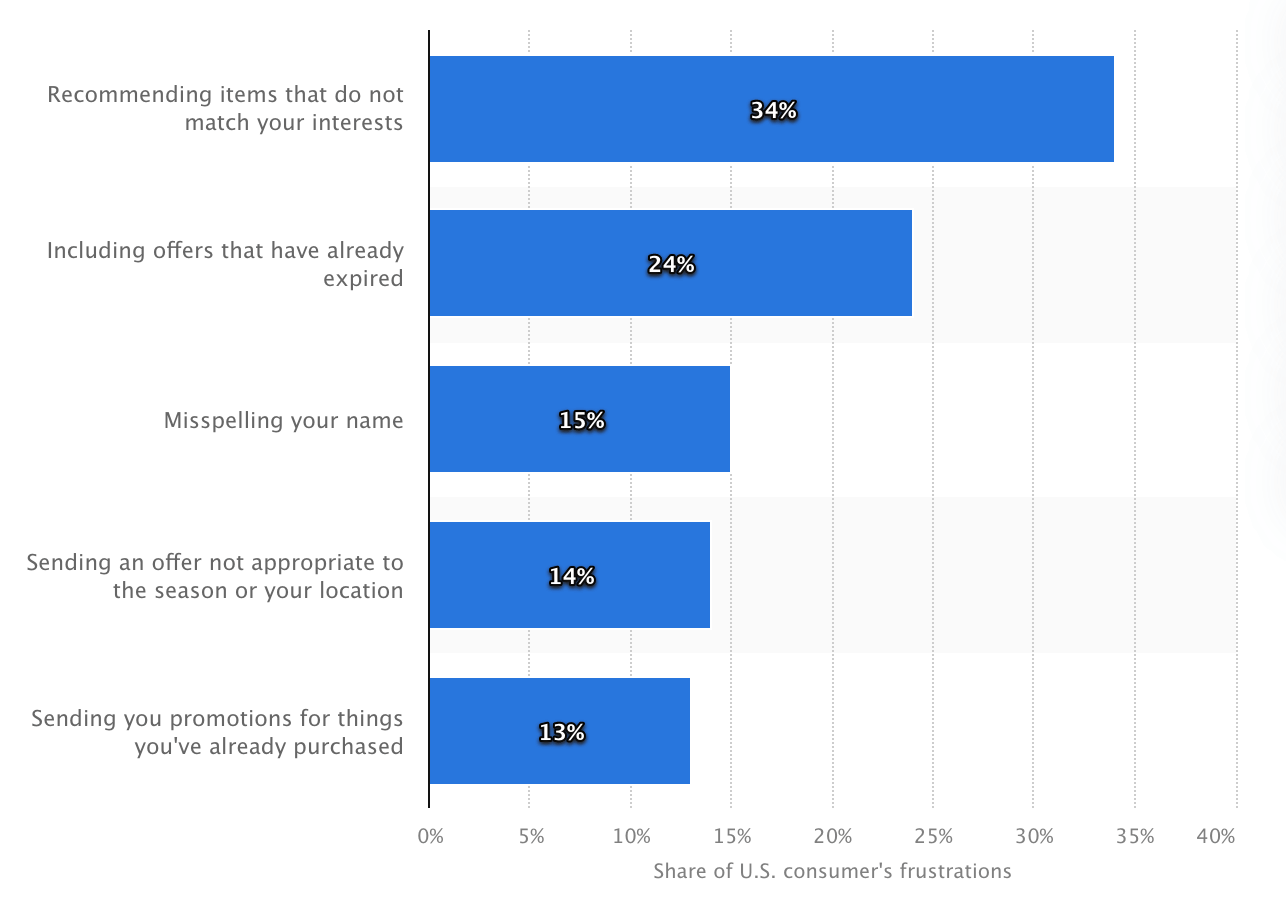
Let’s have a closer look at some pretty bad, yet avoidable mistakes:
#1 Forgetting to personalize
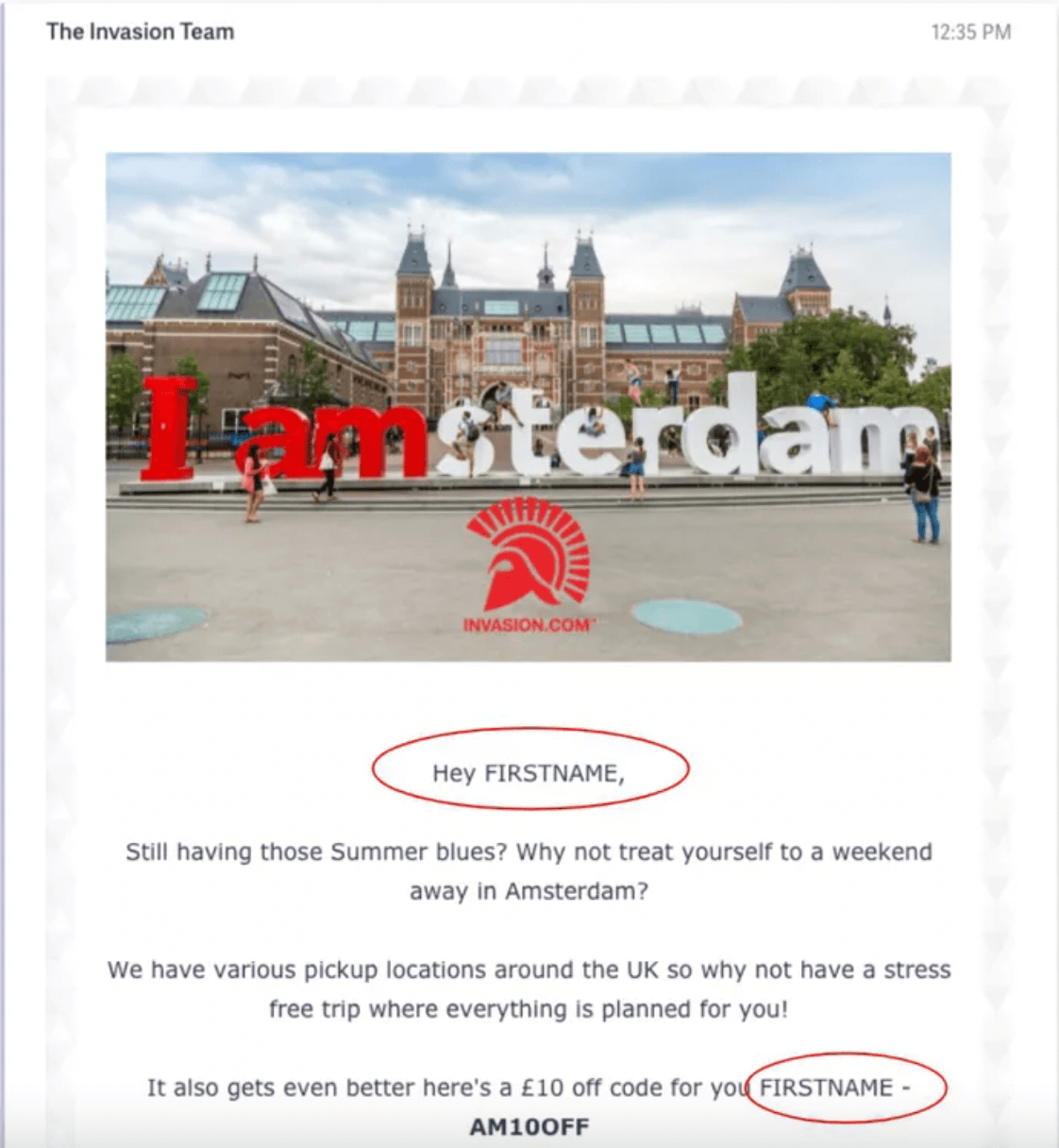
It’s all fun and games until you send an email that says ‘Dear, {first_name}, how’s your week been?’ People won’t click that. In fact, it might actually put them off of your brand entirely and win you a one-way ticket to the spam folder.
No one likes to feel like they’re just another first_name on the list.
Proofreading your code to make sure there are no mistakes like this is simple, needed, and will save you on losing a lot of potential customers for something that can be easily avoided. Another good way to avoid these mistakes is by sending test emails to make sure you see what the user will see.
#2 Sending the wrong email to the wrong user
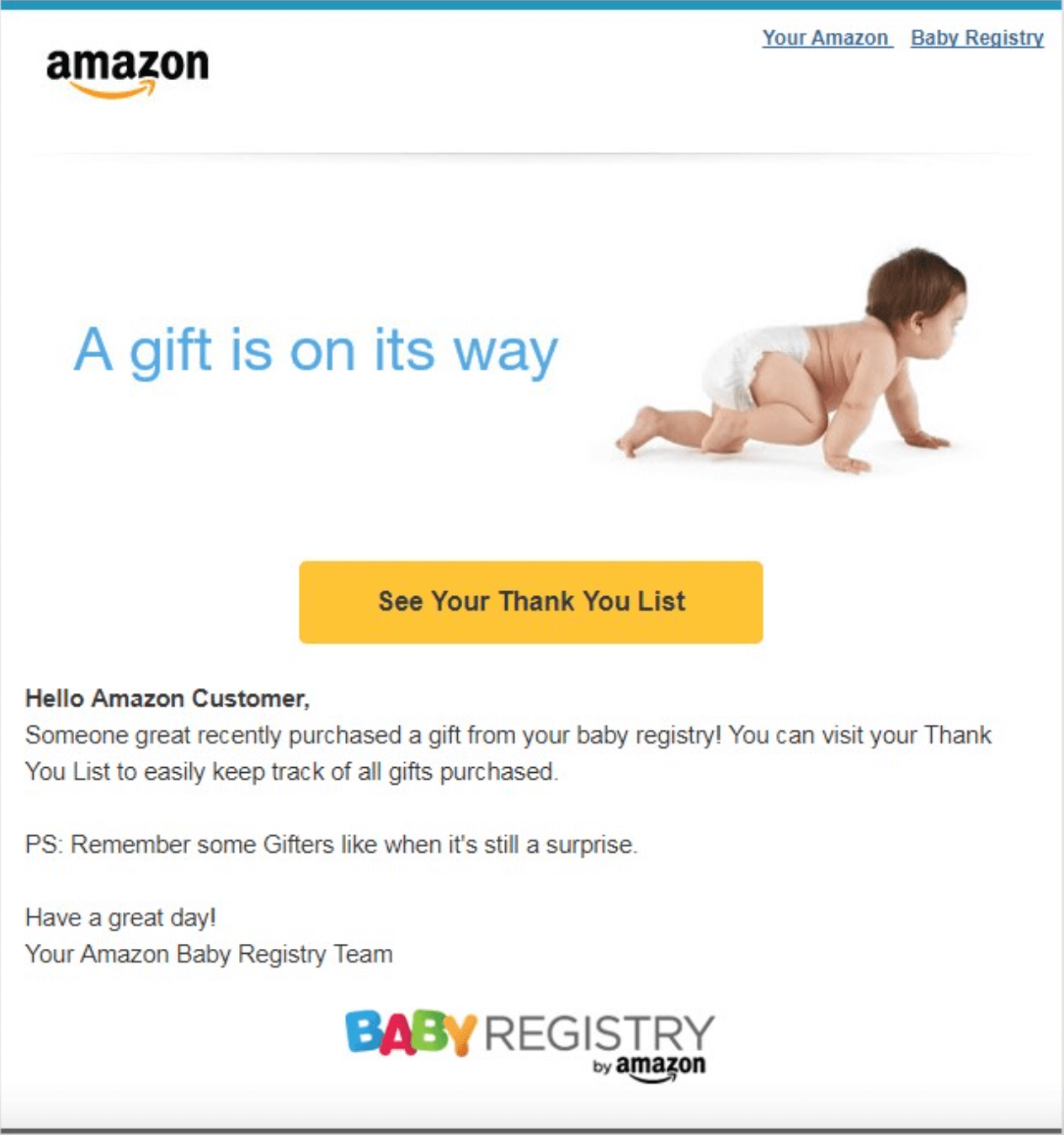
This is one of the biggest mistakes that SaaS companies can make when it comes to their email personalization strategy.
An infamous example is Amazon’s baby registry email in 2017 that was sent to thousands of users that had no babies — it definitely was an awkward message to receive.
As we’ve pointed out, email personalization is more about targeting your user so they feel this message has been tailored to their specific needs. Of course that also comes with the risk of targeting the wrong user!
By failing to reach the ideal customer and filling a potential customer’s inbox with things that haven’t been segmented properly — due to faulty or old data, or simple mistakes in automation — you’re driving future clients away.
Additionally, failing to utilize someone’s data properly rings alarm bells for them on how you’re managing their privacy and data internally. Seeing how over 84% of people care about data and are willing to act in order to protect it, looking after data, or failing to do so, can be the make or break of your brand’s reputation.
This is something that would be fixed with proper email segmentation and automation. Before we dive deeper on the topic you can go check this handy guide about email mapping.
#3 Writing irrelevant subject lines
Subject lines are the introduction to your email. They’re one of the biggest deciding factors for whether a user will click to read, or immediately send to spam or delete your hard work.
In fact, up to 64% of email recipients will decide whether to open the email or not based solely on the subject line. Additionally, up to 69% of email recipients will decide based on the subject line if the email is spam — that’s a high percentage to be playing with.
Be cautious with the length and the language you use in them as they can make or break your email marketing efforts. In fact, personalized subject lines are 50% more likely to be opened.
Personalizing subject lines is definitely worth it, but how should you do it? By adding things like:
- First name
- Birthday
- Interests
- Profession
- Demographic data
You’ll need to remember that subject lines will show up differently on desktop and mobile. Mailchimp advises using up to 9 words and 60 characters for a best-fit for both. Additionally, depending on your industry and target audience, emojis can increase your opening rate on Android by 1,071%, on IOS by 662%.
In the two examples shown below you can see how a short, personalized subject line is more appealing than a plain one. It’s also good that you pay attention to the ‘preview text’ to avoid people thinking your email is spam.
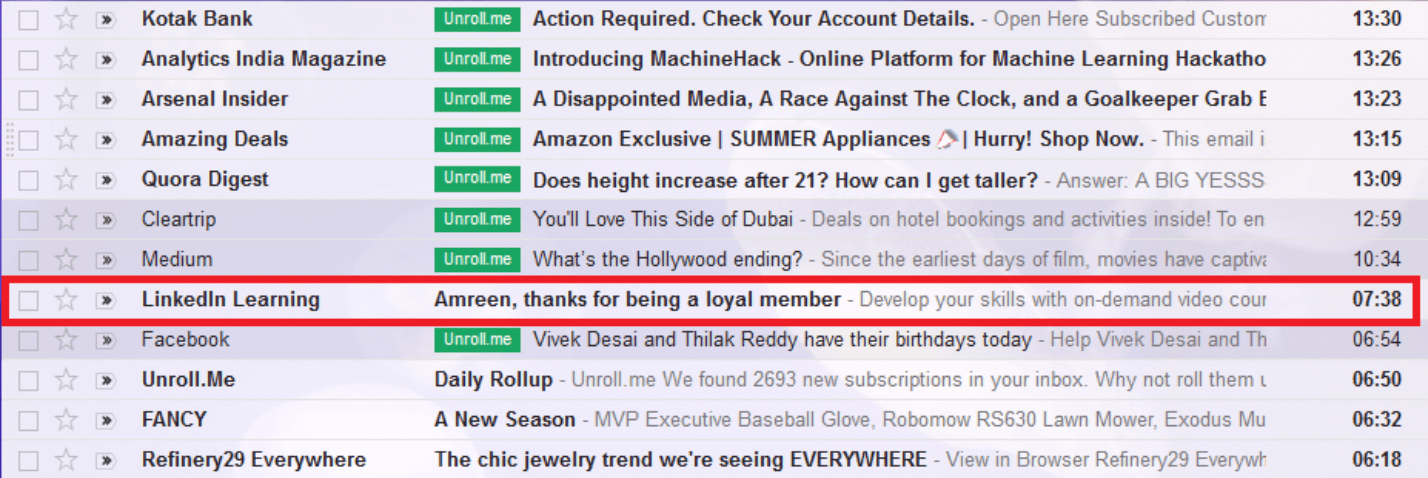
#4 Sending only sales content
This is one mistake that SaaS email marketing campaigns should never make. As we’ve mentioned before, SaaS customers have a very specific pain point they need solving, and before they can subscribe to a new tool, they’ll need to truly understand how your software will help them.
Providing real value and empowering your customers to make the decision by themselves without shoving it down their throats with overly salesly content is key to getting their approval.
A way to avoid this mistake is by focusing on your email sales flows, and looking at them more as nurture journeys. This is a way of handling emails that drives your user down the funnel by considering their entire lifecycle — not just their journey to becoming a customer. From lead nurturing and sales, to onboarding and referral email campaigns, consider it all.
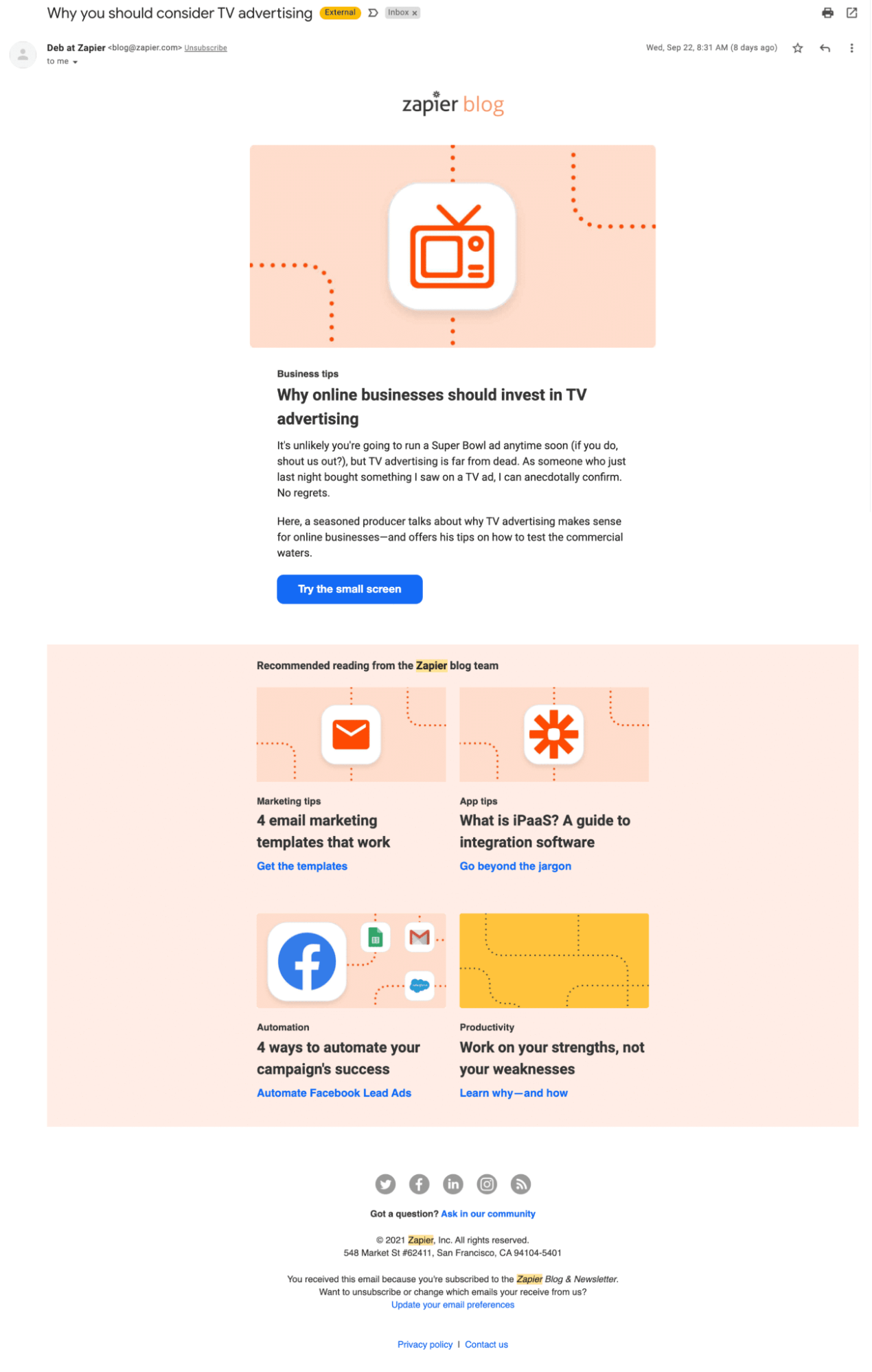
One example of a brand that does a great job of effortless nurture flows is Zapier. They focus on bringing value, educating, and empowering the user so that whether or not they’re ready to make a purchase, they’ll be hooked on the brand and see it as a thought leader within their niche.
Businesses lose up to 38% of customers due to poor marketing personalization efforts — you don’t want to be in that group, so avoid these mistakes and you’ll be gaining and retaining customers.
SaaS email personalization strategies to try
Below we’ve gathered the input of SaaS founders, email marketing consultants, SEO managers, and directors of SaaS sales and marketing, to get you the information you really need.
It’s time to break the cookie cutter! Ready?
Let’s go.
Gather and seize user data
Leslie Venetz, founder at Sales Team Builder, explains that for individuals who are just starting to move to personalized outreach, she’s found the 10-80-10 model to be helpful.
“The gist is that the first and last 10% of the email should be personalized, but the middle 80% can be templated.”
User data is the most popular and straightforward way to understand email personalization.
The data used for this first stage personalization can be names, company names, roles, demographic information, sending preferences, pricing plans, and more. Anything that makes the reader feel like they’re being approached as an individual will help you get on their reading list – not in their spam folder.
Here are some interesting stats in case you’re still not convinced of the power of basic personalization:
- Email subject lines that include personalized elements generate an average of a 50% higher open rate.
- The personalized elements that are most often used are: customer’s name, 46.2%, and company name, 42.9%.
- By addressing the recipient by their name, click-through-rate can be increased up to 35%.
- Failing to personalize–with too little or no personalization at all–can annoy 10% of respondents.
Leslie Venetz also points out:
“Only repeating facts about your prospect back to them to provide 1-2 sentences before you insert a generic sales message, is not going to win the rates you expect.”
It’s a nice starting point, but it’s only the tip of the iceberg of personalization.
Think about timing: behavior-triggered campaigns
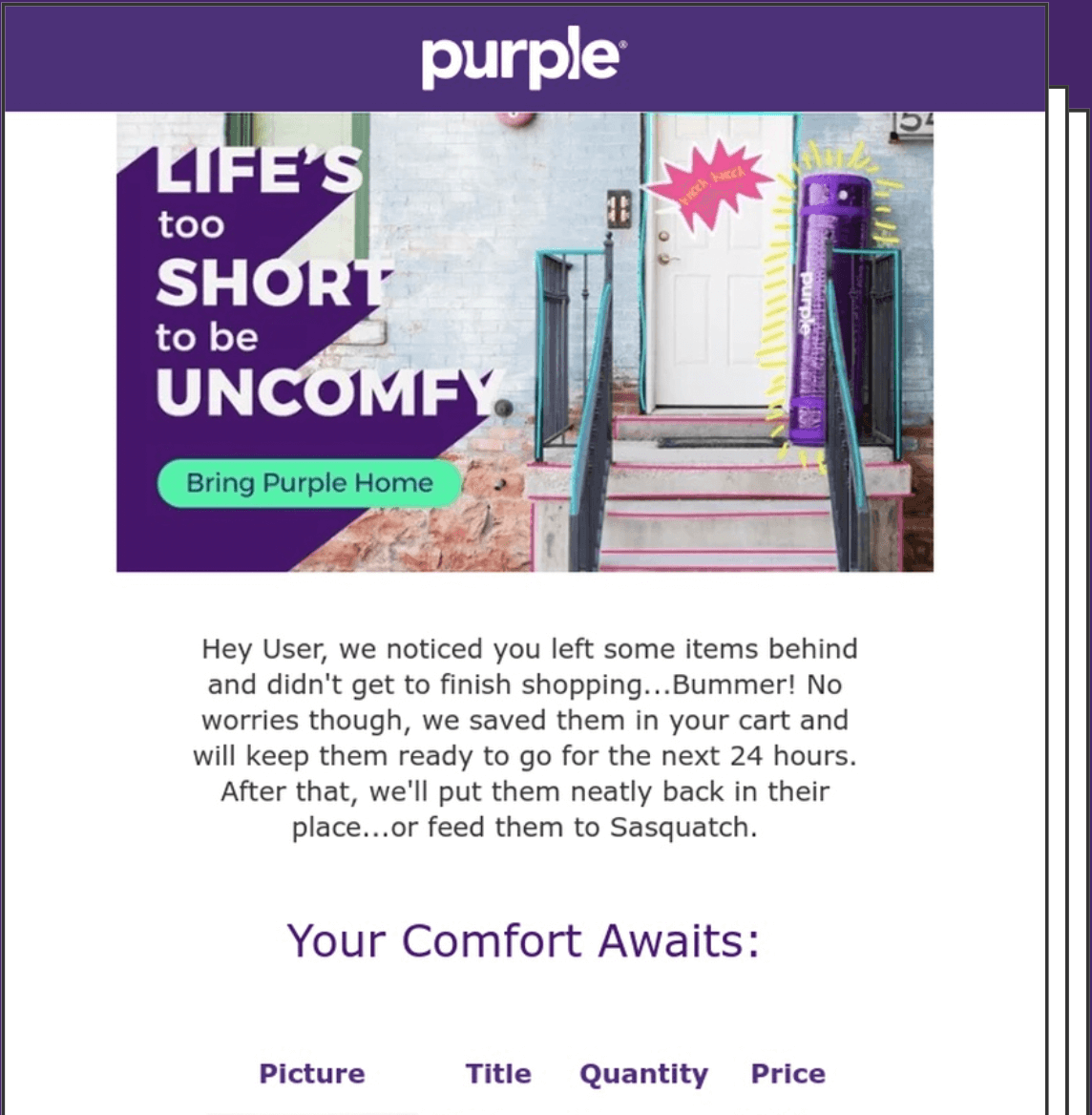
Personalization is not just about the copy or the subject line of the email. In fact, it goes well beyond that.
Behavior-triggered campaigns like reactivation emails, birthday emails, end of free-trial emails, abandoned cart emails, or emails in response to what customers have, or haven’t, used of your product, allow you to provide contextual value – exactly when they need it.
Understanding at what point of the customer journey someone is on with your SaaS, and how you can make your emails more relevant for them is key in making customers feel like their data and insights have been put to good use.
Tristan Harris, demand generation senior marketing manager at Thrive Internet Marketing Agency, explains that personalization is about “offering relevant services and promotions” to the users, which then “increases our open and click-through rates and convert leads into customers.”
Behavior-triggered emails are a great way to get a better seat in your users inbox, they’re opened eight times more and typically generate greater ROI than other sales-orientated emails.
Implement segmentation: user personas
Email personalization goes hand-in-hand with segmentation. Through segmentation you get to deliver the most relevant message to each subscriber, which in turn, drives stronger engagement and business revenue.
A small start-up won’t be using your tool like a big corporation will, not only due to scalability but due to interests and business goals. At the same time,
That’s why the way you approach each group of subscribers will be different — this is where segmentation comes in.
Jordie van Rijn, email marketing consultant at eMailMonday, puts segmentation as easy as “thinking of groups.” Despite your users using the same product, they’ll be using it completely differently depending on who they are.
Segmentation done well can not only help your marketing efforts, but save your SaaS company in its earliest years. Around 35% of SaaS startups fail due to a lack of product-market fit, and 22% due to marketing problems, these are two issues that segmentation faces head on.
To better understand what segmentation is and how to become a wizard at it, visit our guide to segmentation.
Consider the customer lifecycle: stage of awareness
An email for someone who is just discovering your product is completely different from an email to avoid churn, or for sales collateral. Each stage in the customer lifecycle requires different information to make it truly relevant for your potential customer or user. Especially for SaaS brands, stage of awareness is key.
There are five stages of awareness:
- Unaware. The user doesn’t know or care about their problem or your brand
- Pain aware. the user is learning to understand the specific pain point/s they have
- Solution aware. The user understands their pain, and knows there is a solution, but they don’t know yours
- Product aware. The user understands there are various products/tools that are a solution for them, but haven’t decided yet
- Most aware. They understand their problem, the solution, and they trust your brand with the product/tool to solve their problem
Successfully hitting the nail with the content at each stage of awareness will improve brand awareness and increase sales.
Remember, customers don’t buy products, they buy solutions. It’s up to you to prove to them that you have the solution to their problems.
Tim Clarke, director of sales and marketing at SEOBlog.com, says that:
“Through this aspect of email personalization you make your message relevant to your customers, and present your brand as a thought leader in the industry.”
Leverage behavior data: Liquid tags
Personalization is time-consuming, but it’s well worth it. However, there are ways you can save time and resources by simply using tools that have been designed to make your life easier.
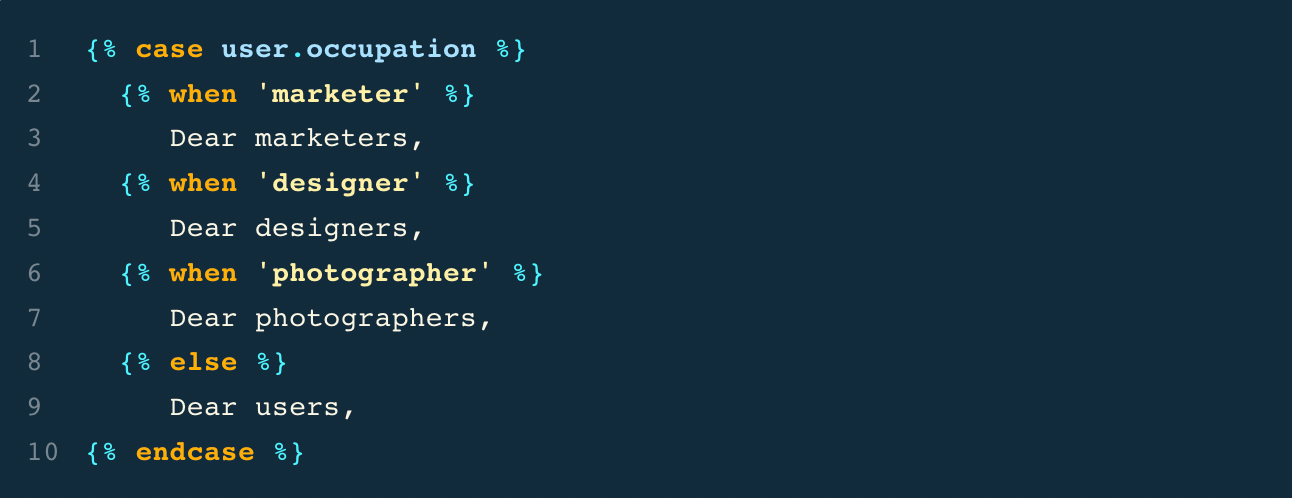
Liquid tags are an open-source template language created by Shopify that allows you to personalize communication with the help of technology. With Liquid tags you can use conditions, insert variables, and do many other things that will help you personalize your campaigns as easy as 1,2,3, and without needing to rewrite an email a hundred times to address each of your segments.
Learn more in our guide to using Liquid for personalization.
Include sender information
People like to feel that your brand is approachable. If you send your email campaigns from a donotreply account, or leave no information on how they can reach you, you’ll be missing out on the final touch of email personalization, connecting with your customers.
By adding sender, email, and signature, you’re making your emails more human. This is even more important for customer success emails, where adding the information of a specific account manager is key for customer experience and retention.
Now that you understand what makes great email personalization.
Don’t wait for the muse. Apply this step-by-step method to write high-performing email campaigns in hours, not weeks.
Closing out with 5 benefits of email personalization
Let’s have a final look at all the benefits email personalization can bring to your company and customers:
Improve customer experience
There’s no better customer experience than understanding the product they’re paying for and feeling like the company cares about them. Email personalization achieves exactly that. In fact, 88% of marketers say the reason to prioritize personalization is to improve customer experience.
Ouriel Lemmel, CEO at WinIt, says email personalization helps them “make their customers engage, and boost sales.”
Cayla Thurman, business reputation consultant at Rize Reviews, thinks that the main benefit of email personalization is:
“Sending emails that give customers tips on using the products they purchased since this significantly increases their loyalty to your company. If you send emails from which they can learn something, it will help them patronize your brand.”
Increase customer retention
Acquiring a new customer is five times more expensive than retaining one. Customer retention is something that email personalization can help you with:
- Up to 52% of customers say they would switch brands if a company doesn’t personalize communications with them.
- A whopping 53% of marketers say ongoing, personalized communication with existing customers results in significant revenue impact.
- Keeping customers despite price changes is key for retention, and through personalization, 50% of customers say they would happily pay more for products and services.
Differentiate yourself from the competition
Email personalization helps increase brand awareness and the overall impact of your campaigns, something key when you’re trying to scale your business with quantity, and quality.
It can also help you stand out from the competition like Jenn Vogel, SVP of Marketing at Voxpopme mentions:
“Email marketing can be a cluttered channel with so many companies trying to reach their prospects. Personalizing our outreach has really been a differentiator to stand out.”
Take full advantage of your data
Data is the name of the game. You’ll be collecting tons of data by now, but until you know how to take advantage of it, that data won’t be doing much good for your bottom line. Learning how to save it and better analyze it will make email personalization and all of your marketing efforts much more effective.
Roberto Popolizio, SEO Manager at Supporthost, says:
“Last year only, we had the opportunity to manage several cold emailing campaigns for the purpose of link building, and indeed personalization has always been the main factor that helped improve not only email deliverability but also our capability to analyze the data and get a better idea of who our prospects are.
This was something I was getting wrong when I started doing email outreach and link-building eleven years ago or so: forgetting that personalisation involves not only the messages themselves but the whole system we are using to drive those conversions.”
Great email personalization requires tons of data, that’s why any tool or system that helps you with your data management will be a crux in your email marketing strategy.
Increase SaaS ROI
Email marketing alone has a ROI of 4200%, that’s $42 for every $1 spent. On top of that, email personalization generates a median ROI of 122%.
One email personalization tool to rule them all
As Roberto Popolizio, SEO manager at Supporthost says:
“The lesson here is that personalization is quite a simple process, but time-consuming and for a reason.”
Anything that helps you speed up the process is a tool you need by your side.
Email marketing automation is what’s going to guarantee your emails get opened, clicked-through and that you get new–if not repeat–business. Tools like Userlist are designed specifically for SaaS companies that want to gather more insightful data, implement better segmentation, and make the whole process as easy as can be.
Start seizing the best of an automated email marketing tool that understands your SaaS business needs with our 14-day free trial, or book a demo-call.
Michael Jonca, community manager at Passport-Photo Online, shared his real-life example of the power or email personalization:
“For six weeks, we’ve been sending not personalized emails. 1,5 months is enough time to determine the success of that approach. Afterward, we decided to re-create our campaigns to be more personalized. And, it turned out to be a bull’s eye. We discovered that personalization boosts our outreach efforts. Our reports show that we’ve doubled our weekly score.”
Follow the advice given here and start personalizing your emails like a real expert. Get ready to see what you can achieve in just a matter of weeks.
SaaS personalized email FAQs
What is email personalization?
Email personalization is email that has been made using the subscriber’s data to provide a highly-tailored and relevant communication experience.
What are the benefits of email personalization?
Email personalizations make subscribers feel seen and heard improving conversion, email open rates, and click-through rates.
What are some practical ways to personalize emails?
By getting basic information like age, name, gender, and birthday you can start to personalize your emails. However, to get better results, it’s best to segment your subscribers through tags or custom fields.
What can be personalized in emails?
Everything can be personalized in your emails. Small things like the subject line and greetings, to the specific content, and frequency of your emails.
Are personalized emails better?
Personalized emails out-perform template emails every time. Up to 74% of marketers say that targeted personalization has increased their overall customer engagement rates.
How to personalize cold emails?
Getting basic user data like name, gender, location, and company name and using it on the subject line can help increase the open rate of cold mails up to 70%.
Don’t miss out on new articles. Subscribe to our newsletter and get your monthly dose of SaaS email marketing insights.






